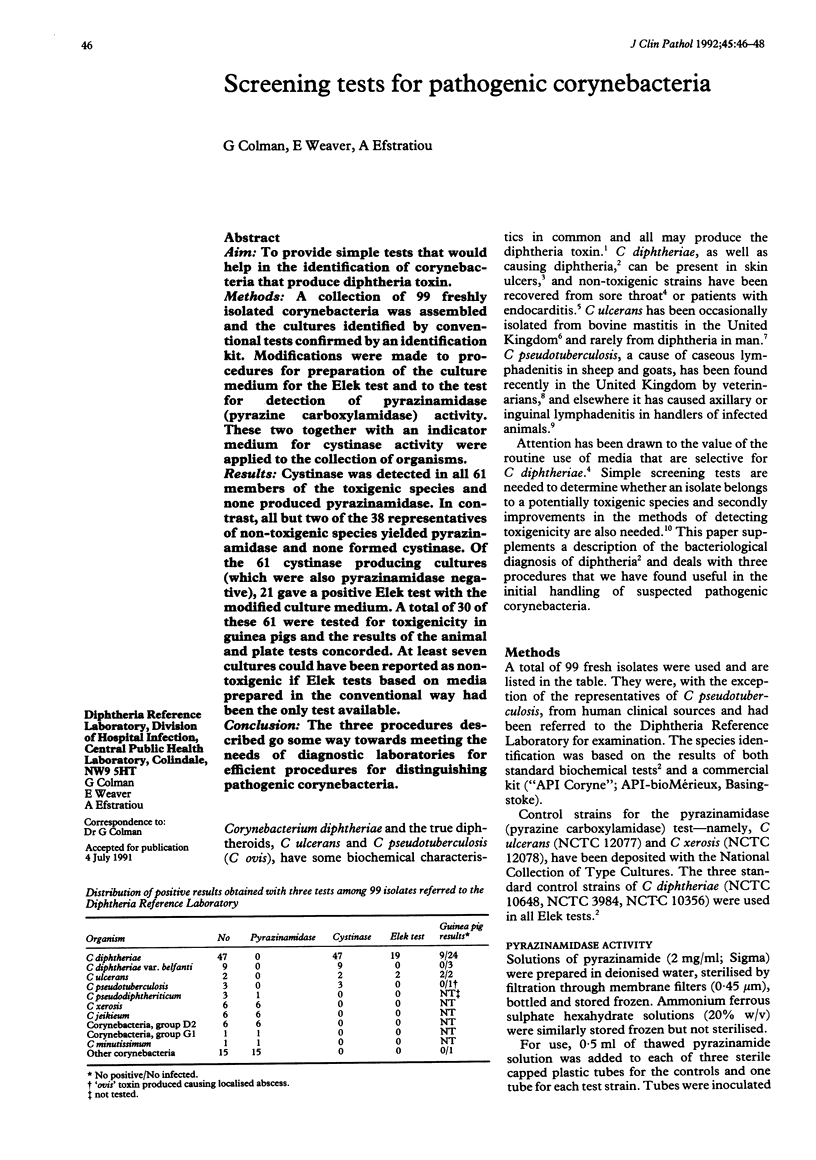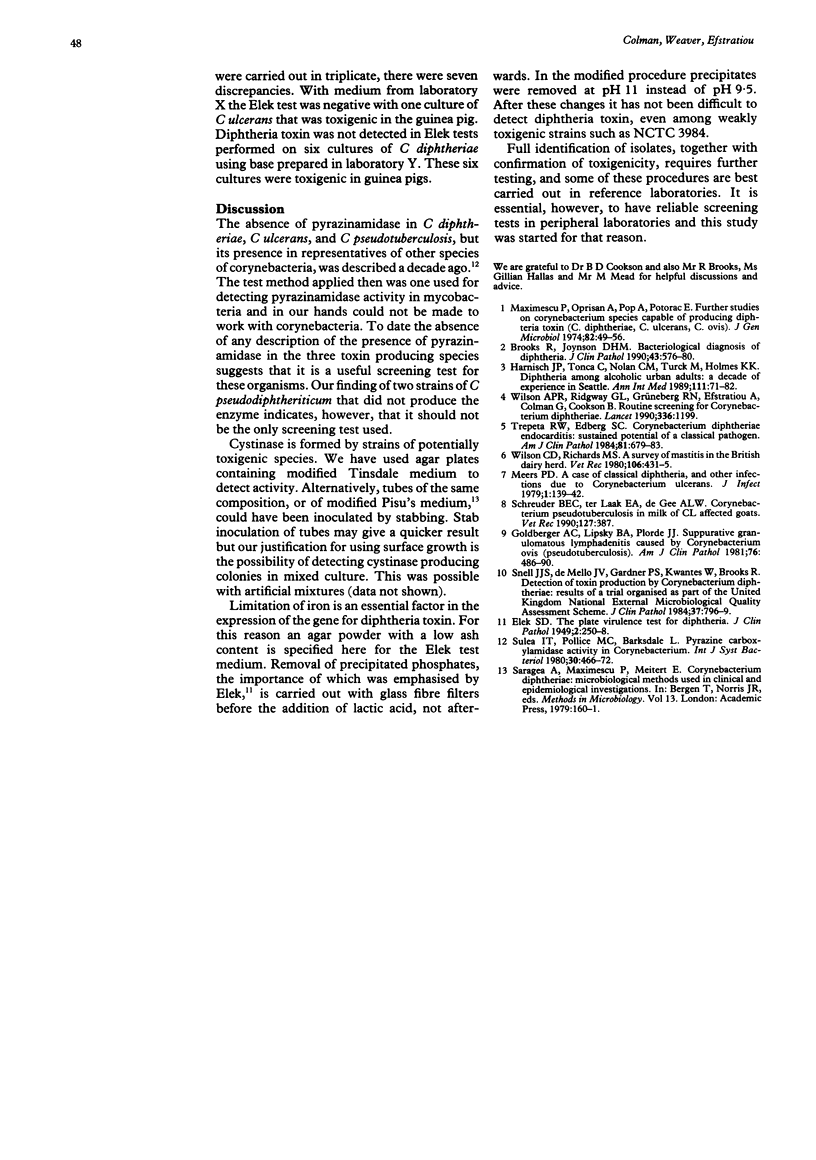Abstract
AIM: To provide simple tests that would help in the identification of corynebacteria that produce diphtheria toxin. METHODS: A collection of 99 freshly isolated corynebacteria was assembled and the cultures identified by conventional tests confirmed by an identification kit. Modifications were made to procedures for preparation of the culture medium for the Elek test and to the test for detection of pyrazinamidase (pyrazine carboxylamidase) activity. These two together with an indicator medium for cystinase activity were applied to the collection of organisms. RESULTS: Cystinase was detected in all 61 members of the toxigenic species and none produced pyrazinamidase. In contrast, all but two of the 38 representatives of non-toxigenic species yielded pyrazinamidase and none formed cystinase. Of the 61 cystinase producing cultures (which were also pyrazinamidase negative), 21 gave a positive Elek test with the modified culture medium. A total of 30 of these 61 were tested for toxigenicity in guinea pigs and the results of the animal and plate tests concorded. At least seven cultures could have been reported as non-toxigenic if Elek tests based on media prepared in the conventional way had been the only test available. CONCLUSION: The three procedures described go some way towards meeting the needs of diagnostic laboratories for efficient procedures for distinguishing pathogenic corynebacteria.
Full text
PDF


Selected References
These references are in PubMed. This may not be the complete list of references from this article.
- Brooks R., Joynson D. H. ACP Broadsheet no 125: July 1990. Bacteriological diagnosis of diphtheria. J Clin Pathol. 1990 Jul;43(7):576–580. doi: 10.1136/jcp.43.7.576. [DOI] [PMC free article] [PubMed] [Google Scholar]
- ELEK S. D. The plate virulence test for diphtheria. J Clin Pathol. 1949 Nov;2(4):250–258. doi: 10.1136/jcp.2.4.250. [DOI] [PMC free article] [PubMed] [Google Scholar]
- Goldberger A. C., Lipsky B. A., Plorde J. J. Suppurative granulomatous lymphadenitis caused by corynebacterium ovis (pseudotuberculosis). Am J Clin Pathol. 1981 Oct;76(4):486–490. doi: 10.1093/ajcp/76.4.486. [DOI] [PubMed] [Google Scholar]
- Harnisch J. P., Tronca E., Nolan C. M., Turck M., Holmes K. K. Diphtheria among alcoholic urban adults. A decade of experience in Seattle. Ann Intern Med. 1989 Jul 1;111(1):71–82. doi: 10.7326/0003-4819-111-1-71. [DOI] [PubMed] [Google Scholar]
- Maximescu P., Oprişan A., Pop A., Potorac E. Further studies on Corynebacterium species capable of producing diphtheria toxin (C. diphtheriae, C. ulcerans, C. ovis). J Gen Microbiol. 1974 May;82(1):49–56. doi: 10.1099/00221287-82-1-49. [DOI] [PubMed] [Google Scholar]
- Schreuder B. E., Ter Laak E. A., De Gee A. L. Corynebacterium pseudotuberculosis in milk of CL affected goats. Vet Rec. 1990 Oct 13;127(15):387–387. [PubMed] [Google Scholar]
- Snell J. J., Demello J. V., Gardner P. S., Kwantes W., Brooks R. Detection of toxin production by Corynebacterium diphtheriae: results of a trial organised as part of the United Kingdom National External Microbiological Quality Assessment Scheme. J Clin Pathol. 1984 Jul;37(7):796–799. doi: 10.1136/jcp.37.7.796. [DOI] [PMC free article] [PubMed] [Google Scholar]
- Trepeta R. W., Edberg S. C. Corynebacterium diphtheriae endocarditis: sustained potential of a classical pathogen. Am J Clin Pathol. 1984 May;81(5):679–683. doi: 10.1093/ajcp/81.5.679. [DOI] [PubMed] [Google Scholar]
- Wilson A. P., Ridgway G. L., Grüneberg R. N., Efstratiou A., Colman G., Cookson B. Routine screening for Corynebacterium diphtheriae. Lancet. 1990 Nov 10;336(8724):1199–1199. doi: 10.1016/0140-6736(90)92823-z. [DOI] [PubMed] [Google Scholar]
- Wilson C. D., Richards M. S. A survey of mastitis in the British dairy herd. Vet Rec. 1980 May 24;106(21):431–435. doi: 10.1136/vr.106.21.431. [DOI] [PubMed] [Google Scholar]


